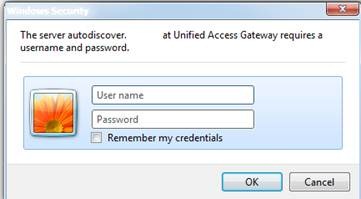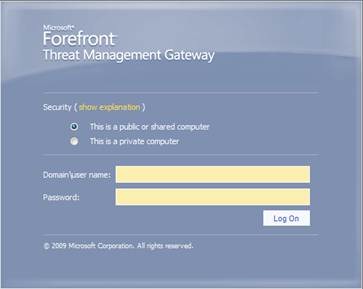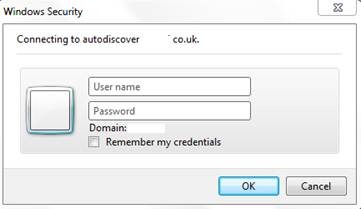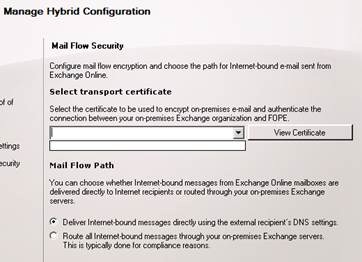Office 365 – Hybrid Configuration Wizard (HCW)
Whilst working on a few O365 engagements over the last month or so I have seen various issues that have been caused by on-premise infrastructure/setup and which have not allowed the HCW (which was introduced in Exchange 2010 SP2) to complete successfully. These issues range from not correctly publishing autodiscover to not having the correct patches/updates installed, so I thought I’d share my experiences.
HCW Issues:-
I have seen issues with the HCW failing on Get-FederationInformation, this can be caused by various things such as:-
· The customer did not publish the autodiscover endpoints correctly to allow O365 to make federated autodiscover lookups
· There is pre-authentication set on the TMG/ISA or UAG. By connecting to https://autodiscover.company.com/autodiscover/autodiscover.xml for example as shown in Figure 1 - Autodiscover pre-auth authenticating - UAG and Figure 2 - Autodiscover pre-auth authenticating - TMG, you can see that UAG/TMG is prompting for pre-auth instead of the auth being directly on exchange, as shown in Figure 3 - No pre-authentication
Figure 1 - Autodiscover pre-auth authenticating - UAG
Figure 2 - Autodiscover pre-auth authenticating - TMG
Figure 3 - No pre-authentication
· You can also run the command in powershell with the –verbose switch to get more detail, such as get-federationinformation……-verbose
· If you are using TMG you can follow this article for configuring TMG with hybrid setups
· You can also check autodiscover and other O365 endpoints (such as AD FS) have been published and are reachable from the internet using the ExRCA
Another issue I have seen is with certificates and as you run through the HCW, under Manage Hybrid Configuration – Mail Flow Security, you are asked to select the certificate that will be used for TLS mail flow between on-prem on and the cloud. If you are using a wildcard cert such as *.company.com then you will need to ensure you are running at least Exchange 2010 SP2 RU1. If you are not running SP2 RU1 then you most probably see an empty box when you get to the certificate page as shown in Figure 4 - HCW certificate blank below.
Figure 4 - HCW certificate blank
Of course you need to also ensure the certificate has been installed onto the exchange hybrid server(s) via the EMC or powershell, you can check using get-exchangecertificate from powershell.
Hybrid steps
Below are the detailed steps that run behind the scenes when you start the hybrid wizard:-
Create Federation Delegation and Organizational Relationships
Creates a new Delegation Federated Trust to 'Microsoft Federation Gateway'
Creates new 'On Premises to Exchange Online Organization Relationship'
Creates new 'Exchange Online to on premises Organization Relationship'
Enables MRSProxy on the Exchange 2010 Hybrid Servers
Configure the 'On Premises to Exchange Online Organization Relationship' to set:-
MailboxMoveEnabled 'True'
FreeBusyAccessEnabled 'True'
FreeBusyAccessLevel 'LimitedDetails' –
ArchiveAccessEnabled 'True'
MailTipsAccessEnabled 'True'
MailTipsAccessLevel 'All'
DeliveryReportEnabled 'True'
TargetOwaURL 'https://outlook.com/owa/<company.com>
Configure the 'Exchange Online to on premises Organization Relationship' to set:-
FreeBusyAccessEnabled 'True'
FreeBusyAccessLevel 'LimitedDetails'
MailTipsAccessEnabled 'True'
MailTipsAccessLevel 'All'
DeliveryReportEnabled 'True'
Create Send and Receive Connectors
HCW creates a new On Premise Send Connector -Name 'Outbound to Office 365' and below is the full output from the send connector created by the HCW:-
AddressSpaces : {smtp:TenantName.mail.onmicrosoft.com;1}
AuthenticationCredential :
Comment :
ConnectedDomains : {}
ConnectionInactivityTimeOut : 00:10:00
DNSRoutingEnabled : True
DomainSecureEnabled : False
Enabled : True
ErrorPolicies : DowngradeAuthFailures
ForceHELO : False
Fqdn : Company.com
HomeMTA : Microsoft MTA
HomeMtaServerId : ServerName
Identity : Outbound to Office 365
IgnoreSTARTTLS : False
IsScopedConnector : False
IsSmtpConnector : True
LinkedReceiveConnector :
MaxMessageSize : 10 MB (You can increase from 10MB which is the default in 2007 and 2010 to 25MB which is set in the service)
Name : Outbound to Office 365
Port : 25
ProtocolLoggingLevel : None
RequireOorg : False
RequireTLS : True
SmartHostAuthMechanism : None
SmartHosts : {}
SmartHostsString :
SmtpMaxMessagesPerConnection : 20
SourceIPAddress : 0.0.0.0
SourceRoutingGroup : Exchange Routing Group (DWBGZMFD01QNBJR)
SourceTransportServers : {ServerName}
TlsAuthLevel : DomainValidation
TlsDomain : outlook.com
UseExternalDNSServersEnabled : False
HCW creates a new On Premise Receive Connector 'Inbound from Office 365' on each of the Hybrid HT servers and below is the full output from the receive connector created by the HCW:-
AuthMechanism : Tls, Integrated, BasicAuth, BasicAuthRequireTLS
Banner :
BinaryMimeEnabled : True
Bindings : {LocalIP:25}
ChunkingEnabled : True
DefaultDomain :
DeliveryStatusNotificationEnabled : True
EightBitMimeEnabled : True
BareLinefeedRejectionEnabled : False
DomainSecureEnabled : False
EnhancedStatusCodesEnabled : True
LongAddressesEnabled : False
OrarEnabled : False
SuppressXAnonymousTls : False
AdvertiseClientSettings : False
Fqdn : Company.com
Comment :
Enabled : True
ConnectionTimeout : 00:10:00
ConnectionInactivityTimeout : 00:05:00
MessageRateLimit : unlimited
MessageRateSource : IPAddress
MaxInboundConnection : 5000
MaxInboundConnectionPerSource : 20
MaxInboundConnectionPercentagePerSource : 2
MaxHeaderSize : 64 KB (65,536 bytes)
MaxHopCount : 60
MaxLocalHopCount : 12
MaxLogonFailures : 3
MaxMessageSize : 28 MB (29,360,128 bytes)
MaxProtocolErrors : 5
MaxRecipientsPerMessage : 200
PermissionGroups : AnonymousUsers
PipeliningEnabled : True
ProtocolLoggingLevel : None
RemoteIPRanges : {RemoteIP Ranges}
RequireEHLODomain : False
RequireTLS : True
EnableAuthGSSAPI : False
ExtendedProtectionPolicy : None
LiveCredentialEnabled : False
TlsDomainCapabilities : {outlook.com:AcceptOorgProtocol}
Server : LocalServerName
SizeEnabled : Enabled
TarpitInterval : 00:00:05
MaxAcknowledgementDelay : 00:00:30
AdminDisplayName :
ExchangeVersion : 0.1 (8.0.535.0)
Name : Inbound from Office 365
DistinguishedName : CN=Inbound from Office 365,CN=SMTP Receive Connectors,CN=Protocols,etc…
Identity : LocalServerName\Inbound from Office 365
Guid : 9feef51e-1bd9-4aa4-9202-0614a1fcc0dd
ObjectCategory : company.com/Configuration/Schema/ms-Exch-Smtp-Receive-Connector
ObjectClass : {top, msExchSmtpReceiveConnector}
OriginatingServer : ServerName
IsValid : True
There are also some connectors created in Forefront Online Protection for Exchange (FOPE). The connector created in FOPE will be called ‘Hybrid Mail Flow Inbound Connector’ and will have the following settings (assuming you are routing mail back on-premise):-
Description: The Hybrid Mail Flow inbound connector was created when hybrid mail flow was configured. This connector cannot be modified.
Sender Domains: *.*
Sender IP Addresses:
Transport Layer Security (TLS) Settings: Forced TLS, and certificate matches specified domain
The recipient certificate matches: mail.company.com
Filtering Settings: Add these IP addresses to the safelist and only accept mail from these IP addresses for the domains specified above
IP Reputation Filtering: Disabled
Spam Filtering: Disabled
Policy Rules: Disabled
The other connector created in FOPE will be called ‘Hybrid Mail Flow Outbound Connector’ and will have the following settings:-
Description: The Hybrid Mail Flow outbound connector was created when hybrid mail flow was configured. This connector cannot be modified.
Recipient Domains: mail.company.com,*.*
Message Delivery Settings:
Fully Qualified Domain Name: mail.company.com
Transport Layer Security (TLS) Settings: Forced TLS, and certificate matches specified domain
The recipient certificate matches: mail.company.com
Create Remote Domains
Create new Remote Domain 'Hybrid Domain – company.com' set with:-
TrustedMailInbound 'True'
Create new Remote Domain 'Hybrid Domain - TenantName.mail.onmicrosoft.com' set with:-
TrustedMailOutbound 'True'
TargetDeliveryDomain 'True'
AllowedOOFType 'InternalLegacy'
AutoReplyEnabled 'True'
AutoForwardEnabled 'True'
DeliveryReportEnabled 'True'
DisplaySenderName 'True'
NDREnabled 'True'
TNEFEnabled 'True'
Create new Remote Domain 'Hybrid Domain - mail.company.com '
DomainName 'mail.company.com'
TrustedMailInbound 'True
Setup Hybrid Mailflow
Set Hybrid Mailflow to:-
SecureMailEnabled 'True'
CentralizedTransportEnabled 'True'
OnPremisesFQDN 'mail.company.com '
CertificateSubject 'mail.company.com '
InboundIPs <>
OutboundDomains <>
Set Address Policies
Update Default Recipient Policy to add <alias>@TenantName.mail.microsoft.com
Apply the updated Default Recipient Policy immediately
Written by Daniel Kenyon-Smith



